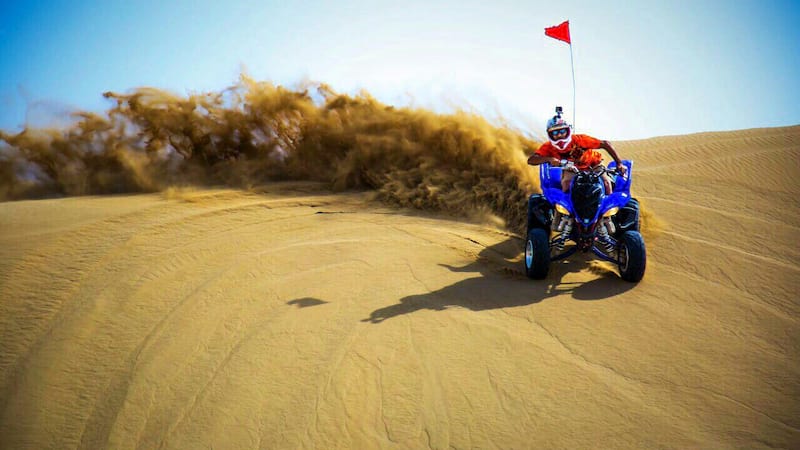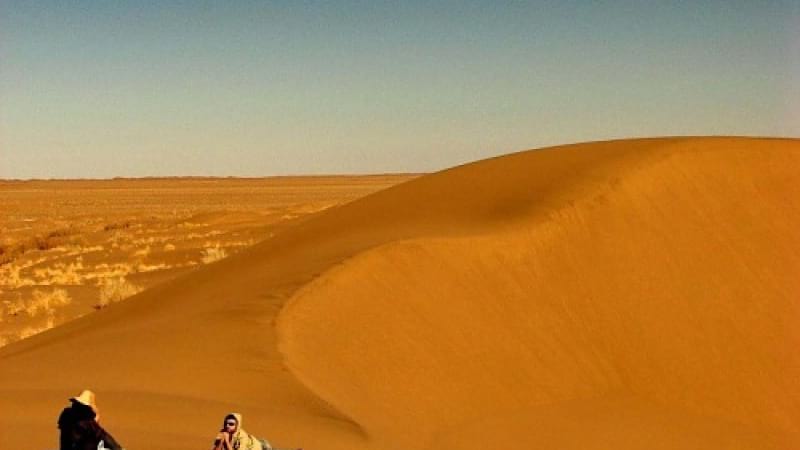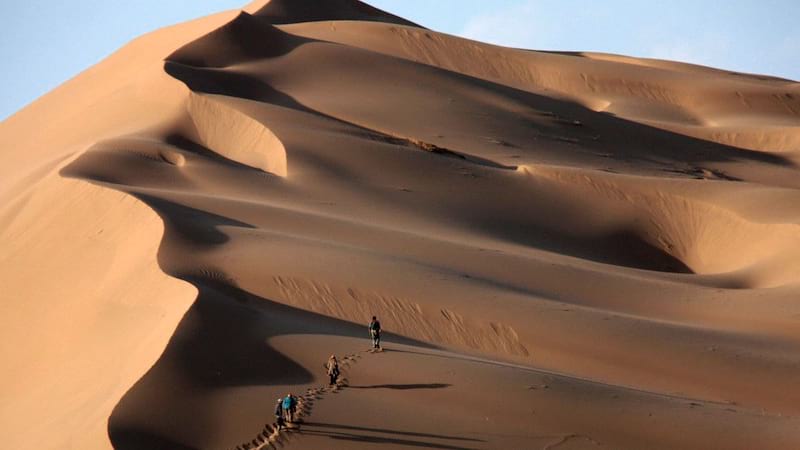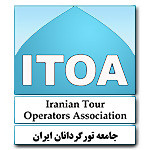Starting point: Isfahan's Airport
Destination: Isfahan, Naeen, Jandaq, Damghan, Shahmirzad, Semnan
Departure time: Depends on the arrival's time
Hotel pickups commence approximately 10 minutes prior to this time, exact pickup time will be advised on reconfirmation.
Duration: 7-Day
Return details: Returns to original departure point or Tehran Hotels
Itinerary
Day 1
On the first day, we'll meet at Isfahan Airport. After checking in the hotel, we pay a visit to ancient monuments whole the day.
The Meidan Emam is a public urban square in the center of Isfahan, a city located on the main north-south and east-west routes crossing central Iran. It is one of the largest city squares in the world and an outstanding example of Iranian and Islamic architecture. Built by the Safavid Shah Abbas I in the early 17th century, the square is bordered by two-storey arcades and anchored on each side by four magnificent buildings: to the east, the Sheikh Lotfallah Mosque; to the west, the pavilion of Ali Qapu; to the north, the portico of Qeyssariyeh; and to the south, the celebrated Royal Mosque. A homogenous urban ensemble built according to a unique, coherent, and harmonious plan, the Meidan Emam was the heart of the Safavid capital and is an exceptional urban realization.
Chehel Sotoun (also Chehel Sotoon) is a pavilion in the middle of a park at the far end of a long pool, in Isfahan built by Shah Abbas II to be used for the Shah's entertainment and receptions. In this palace, Shah Abbas II and his successors would receive dignitaries and ambassadors, either on the terrace or in one of the stately reception halls.
Once the most luxuriously decorated palace in Esfahan, the interior of the small Hasht Behesht Palace has been extensively damaged over the years, but it retains some spectacular details, including a superb stalactite ceiling with delicate painting. The same keyhole plasterwork seen in the Kakh-e Ali Qapu is featured on a small scale here too. The soaring wooden columns on the palace's open-sided terrace are almost as tall as those still growing in the parkland that frames it. A popular meeting place for retired Esfahani men, the park has a seductive tranquillity that offers the promise of peace in a city of pace.
Masjed-e JÄme’ is the oldest Friday (congregational) mosque in Iran, located in the historical center of Isfahan. The monument illustrates a sequence of architectural construction and decorative styles of different periods in Iranian Islamic architecture, covering 12 centuries, most predominantly the Abbasid, Buyid, Seljuq, Ilkhanid, Muzzafarid, Timurid and Safavid eras. Following its Seljuq expansion and the character introduction of the four iwans (Chahar AyvÄn) around the courtyard as well as two extraordinary domes, the mosque became the prototype of a distinctive Islamic architectural style.
In Iran, there are some minarets which have the ability to shake called Monar Jonban; The most famous Monar Jonban, one is located in Isfahan and other in Ardakan and Kharanegh. The Monar Jonban (Shaking Minarets) is a monument located in Isfahan in which mystic known as “Uncle Abdullah Karladany†was buried. It is a building with 9-meter width and 17-meters height and famous for its shaking minarets; when one of the minarets shakes, the other one start shaking and whole building too.
Iran has many archaeological wonders to admire from ancient time. One of them is the Zoroastrian fire temple Atashgah in the big city Esfahan - Isfahan. It is well constructed and has its own charm, but can not compete with other Iranian wonders which are notified on UNESCO's World Heritage list as Bam and its Cultural Landscape (2004), Pasargadae (2004), Persepolis (1979), Soltaniyeh (2005), Takht-e Soleyman (2003), Tchogha Zanbil (1979) and the amazing building the Meidan Emam Mosque in Esfahan (1979). Anyway, Atashgah is a great wonder. Other great wonders in Esfahan are the Friday Mosque, the Shaky Minarets, Christian churches in the Jolfa district and the bridges across the Zayandeh river. The mentioned Zoroastrian fire temple is rising up from the top of a hill. It`s the only one in Esfahan and there is the special story behind it. Overnight in Isfahan.
Day 2
On the second day, whole the day, visiting Isfahan, we'll find the new adventure.
Alongside the Islamic and Persian landmarks, one of the most visited places in Persia’s ancient capital Isfahan, and one of the must-see sights of every Iran tour is the Vank Cathedral, also called off the Saint Savior, in the city’s Armenian district of New Julfa. Named after the city of Julfa in Armenia, the quarter was created by Safavid-dynasty Shah Abbas the Great following the deportation of thousands of Armenians between the 1603 and 1605 after the war against the Ottoman Empire. What today looks like a cozy and quaint neighborhood was very much welcomed by Shah Abbas I as Armenians’ knack for arts and craftsmanship has always been very well-known in the region.
The Armenian quarter of Isfahan dates from the time of Shah Abbas I, who transported a colony of Christians from the town of Julfa (now on Iran’s northern border) en masse, and named the village ‘New Julfa’. Abbas sought their skills as merchants, entrepreneurs, and artists and he ensured that their religious freedom was respected – albeit at a distance from the city’s Islamic center. At one time over 42,000 Armenian Christians lived here.
Eleven bridges cross the Zayandeh River in Isfahan (Esfahan). Six of these are modern constructions but the other five crossings date from the Safavid period and earlier in the case of the Shahrestan Bridge. Except for the shorter Marnan Bridge (Pol-e Marnam), the other historic bridges lie to the east of Chahar Bagh Street. The 298m Si-o-Seh Bridge (Pol-e Si-o-Seh) which is known as the Bridge of 33 Arches or Allahverdi Khan Bridge. Allahverdi Khan, a general of Shah Abbas I, completed the bridge in 1602 and the structure acts both as a crossing and a dam. There is a famous teahouse at the northern end of the bridge. Overnight in Isfahan.
Day 3
Drive to Naeen (146km), have a visit to Naeen's sightseeing.
More than 3,000 years ago the Persians learned how to construct aqueducts underground (qanat in Persian or kariz) to bring water from the mountains to the plains. In the 1960s this ancient system provided more than 70 per cent of the water used in Iran and Na’in is one of the best places in all the world to see these qanats functioning.
Unique to Na’in are some of the most outstanding monuments in all of Iran: the Jame Mosque, one of the first four mosques built in Iran; the Pre-Islamic Narej Fortress; a Pirnia traditional house; the Old Bazaar; Rigareh, a qanat-based watermill; and a Zurkhaneh (a place for traditional sport).
Besides its magnificent monuments, Na’in is also famous for high-quality carpets and wool textile and homemade pastry (copachoo). Overnight in Naeen.
Day 4
Drive across Naeen towards Anarak, Chopanan, and Jandaq (219km).
Anarak is located at the edge of the 'Dasht-e Kavir' and about 75 km from the city of Nain. The city is surrounded by ruins of an old wall and three watchtowers, which were built about 100 years ago to keep Hossein Kashi and his bandit gang out. There is little agriculture in this region, but there are many mines located near Anarak. Nakhlalk, a lead mine, is the largest active mine near Anarak.
Jandaq is a small city located south of the central desert of Iran, northeast of Isfahan province and is an administrative division of Na’in city. Jandaq is the combination of two Persian words, that is, Janb (next to) and Daq (desert). The city is located at the heart of the desert and it is hard to go there. However, the city attracts a lot of domestic and foreign tourists every year. The small city contains many tourist attractions as follows. Overnight at Mesr Village.
Day 5
Have a visit to the Jandaq sightseeing and Mesr desert.
What do you recall when you hear “Mesr� The Arabic name of Egypt, a country in North Africa? Nile River, Pyramids, Sphinx, and Pharaohs? You are right. But you would be surprised to know, there’s another Mesr too, but thousands of kilometers away from current Egypt, and tens of kilometers away from any crowded city. A small island in the sand, somewhere in the heart of Iran’s central desert, Mesr is the name of an Iranian village in Khur and Biabanak county, close to the city of Naein which is famous for agricultural production in the area. Overnight at Mesr Village.
Day 6
Drive from Jandaq to Damqan (261km) and Opert nomads.
Damghan is one of the oldest cities on the Iranian plateau, stretching back 7000 years, and boasts many sites of historic interest. The oldest of these is Tappeh Hessar, lying to the southeast of the city, which holds the ruins of a castle dating from the Sassanid period.
The Tarikhaneh is one of the oldest mosques in Iran, built like a fire temple during the Sassanid dynasty it was converted into a mosque after the advent of Islam. There are also many other historical buildings belonging to Seljuks and other periods. Apart from its historical interest, the city today is mainly known for pistachios and paper almonds (kaghazi) with very thin shells. Overnight at Semnan.
Day 7
have a visit to Semnan sightseeings, drive to Tehran (339km).
Jame' Mosque of Semnan – built nearly 1,000 years ago by the Seljuq Turks over what used to be an ancient Zoroastrian fire temple. This ancient mosque also includes the famous Seljuq minaret with archaic carvings and designs.
The Gate of the Semnan Fortress – built by the Qajar dynasty under Prince Bahman Mirzaye Baha'ed-dowleh, the son of Fath Ali Shah Qajar. Unfortunately, Reza Shah Pahlavi destroyed the other three entrances and the walls around the old city under the pretext of road construction.
Semnan Bazaar – the place to buy the souvenirs, handicrafts, appliances, food items, etc. Overnight in Tehran.
Day 8
It's last day and after having breakfast, we transfer to the Imam Khomeini Intl. Airport.
Please note
Itinerary may change due to cultural reasons, seasonal changes, Operational logistics and accessibility.
There is a chance to change the itinerary as you desire, please do not hesitate to contact us.









